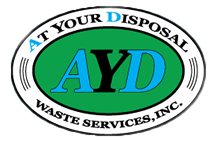AYD Waste can typically recycle 98% of construction debris. Unfortunately, it isn’t general knowledge that the majority of construction materials can be recycled. During any major demolition, reconstruction, or new construction project, large amounts of refuse are inevitably generated. However, almost everything from packaging to large chunks of cement can be recycled and cycled back into the economy in a myriad of different shapes and forms, many of which are rather surprising! The green movement has been gaining awareness and support over the past fifty years, and as a result, we are constantly finding new ways to recycle almost anything! But just how is all this junk really used? We’ve come up with an interesting list of reclaimable construction materials and how they are used.
Concrete:
Small fragments of concrete are ground down or crushed for a variety of different purposes. A layer of recycled concrete is laid down before asphalt is spread when making new roads. Often re-paved or improved roadways are made largely of the original concrete road they replace. When ground very finely, it can be used as dry aggregate for new concrete. Larger hunks of concrete are used as riprap, a highly effective method of erosion prevention along waterways.
Asphalt:
The most common use for old asphalt roads and roofing tiles is new asphalt. This is known as Reclaimed Asphalt Pavement (RAP). Recycled asphalt can be used to make warm-mix asphalt, which allows it to be mixed at much lower temperatures, resulting in reduced carbon emissions and energy usage.
Glass:
Did you know that glass is 100% recyclable, and can be recycled endlessly without compromising quality or purity? Furnace ready scrap glass is known as “cullet,” and is used to make new glass for a variety of industrial and consumer purposes. Additionally, scrap glass is used to make fiberglass, which has limitless usage options in and of itself.
Metal:
Most types of metals can be melted and recycled for use in new products. Iron and aluminum are often used to build structures, for automobile parts and aircrafts. New studies show reclaimed metal can be used to detoxify waste water. Recycled metal can be melted at a lower temperature than virgin metals, saving energy and cutting Co2 emissions. Recycled metal is used to make containers, consumer goods, tools, furniture, and more.
Plastics:
There is a vast array of types of plastics, almost all of which can be recycled and repurposed, reducing environmental impact. Plastics are most commonly recycled and formed back into food/beverage containers and packing, but there are endless other applications. Polymers can often be converted into petroleum, to be used for new polymer production, or as fuel. Heat compression allows different types of plastics to be melted down together, for more flexible usage. Plastic PET bottles are currently widely used to produce polyester fabrics, for durable, tough clothing, such as jackets, shoes, or handbags.
Carpeting:
Carpets have even more uses than most people realize; they can be broken down and made into new carpets, and more. At times they become carpet cushion, or plastic-wood composite material frequently used to make furniture such as park benches. Automobile parts frequently contain recycled carpet material. Additionally, it can be used for erosion control as mesh underlayment, sediment control and soil stabilization.
Other materials that can be recycled include insulation, rubber tires, rocks, dirt, sand and cardboard. Recycling is on the rise thanks to increased consumer and industrial awareness. Each year recycling keeps billions of pounds of waste out of landfills, and is continuing to increase and improve each and every day.


